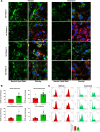A patient-based iPSC-derived hepatocyte model of alcohol-associated cirrhosis reveals bioenergetic insights into disease pathogenesis
- PMID: 38693144
- PMCID: PMC11063145
- DOI: 10.1038/s41467-024-47085-y
A patient-based iPSC-derived hepatocyte model of alcohol-associated cirrhosis reveals bioenergetic insights into disease pathogenesis
Abstract
Only ~20% of heavy drinkers develop alcohol cirrhosis (AC). While differences in metabolism, inflammation, signaling, microbiome signatures and genetic variations have been tied to the pathogenesis of AC, the key underlying mechanisms for this interindividual variability, remain to be fully elucidated. Induced pluripotent stem cell-derived hepatocytes (iHLCs) from patients with AC and healthy controls differ transcriptomically, bioenergetically and histologically. They include a greater number of lipid droplets (LDs) and LD-associated mitochondria compared to control cells. These pre-pathologic indicators are effectively reversed by Aramchol, an inhibitor of stearoyl-CoA desaturase. Bioenergetically, AC iHLCs have lower spare capacity, slower ATP production and their mitochondrial fuel flexibility towards fatty acids and glutamate is weakened. MARC1 and PNPLA3, genes implicated by GWAS in alcohol cirrhosis, show to correlate with lipid droplet-associated and mitochondria-mediated oxidative damage in AC iHLCs. Knockdown of PNPLA3 expression exacerbates mitochondrial deficits and leads to lipid droplets alterations. These findings suggest that differences in mitochondrial bioenergetics and lipid droplet formation are intrinsic to AC hepatocytes and can play a role in its pathogenesis.
© 2024. This is a U.S. Government work and not under copyright protection in the US; foreign copyright protection may apply.
Conflict of interest statement
The authors do not have any financial and non-financial interest in design or preparation of the manuscript. D.M. receives a salary from Leica Microsystems where he is Manager for Aivia Software, however received no compensation to assist for this manuscript. A.J.S. have stock options in Genfit, Akarna, Tiziana, Durect Inversago, and Galmed. He has served as a consultant to Astra Zeneca, Salix, Tobira, Takeda, Jannsen, Gilead, Terns, Birdrock, Merck, Valeant, Boehringer Ingelheim, Bristol Myers Squibb, Lilly, Hemoshear, Novartis, Novo Nordisk, Pfizer, 89 bio, Regeneron, Alnylam, Akero, Tern, Histoindex, Corcept, Poxel, Path AI, and Genfit. His institution has received grant support from Gilead, Salix, Tobira, Bristol Myers, Shire, Intercept, Merck, Astra Zeneca, Malinckrodt and Novartis. He receives royalties from Elsevier and UptoDate. However, A.J.S. received no compensation from any source for this manuscript.
Figures








References
-
- NIAAA. Alcohol Use Disorder (AUD) in the United States: Age Groups and Demographic Characteristics. (2023).
-
- CDC. Chronic Liver Disease and Cirrhosis, (2023).
-
- HRSA. OPTN/SRTR 2019 Annual Data Report: Liver) (2019).
Publication types
MeSH terms
Substances
Grants and funding
LinkOut - more resources
Full Text Sources
Molecular Biology Databases
Research Materials

